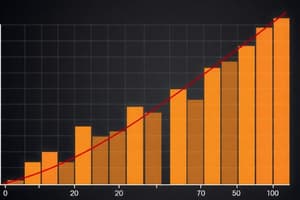Podcast
Questions and Answers
What is multivariate analysis?
What is multivariate analysis?
It is a statistical technique that analyzes more than two variables at once.
Which of the following categories of analysis focuses on just one variable?
Which of the following categories of analysis focuses on just one variable?
- Univariate analysis (correct)
- Bivariate analysis
- Multivariate analysis
- None of the above
In marketing, what variable might you analyze in relation to the number of sales?
In marketing, what variable might you analyze in relation to the number of sales?
- Money spent on advertising (correct)
- Customer demographics
- Sales team performance
- Product quality
Match the following multivariate analysis techniques with their types:
Match the following multivariate analysis techniques with their types:
Interdependence methods look for causal relationships among variables.
Interdependence methods look for causal relationships among variables.
The dependent variable 'weight' might be predicted by independent variables such as 'height' and ____.
The dependent variable 'weight' might be predicted by independent variables such as 'height' and ____.
What is the primary goal of multivariate analysis?
What is the primary goal of multivariate analysis?
Flashcards are hidden until you start studying
Study Notes
Overview of Multivariate Analysis
- Data analytics focuses on evaluating multiple factors to assess their impact on situations and outcomes.
- Multivariate analysis is employed when analyzing data with more than two variables.
- It encompasses various statistical techniques, allowing for deeper insights into business and real-world scenarios.
Understanding Multivariate Analysis
- Key to understand relationships between different variables, for example:
- Marketing: How "money spent on advertising" affects "number of sales."
- Healthcare: Exploring the correlation between "weekly hours of exercise" and "cholesterol level."
- It aids in interpreting outcomes and improving future predictions and decisions.
Categories of Analysis
- Univariate analysis: Examines a single variable.
- Bivariate analysis: Involves two variables for analysis.
- Multivariate analysis: Engages multiple variables simultaneously to uncover patterns and correlations.
Importance of Multivariate Analysis
- Offers a more comprehensive understanding of scenarios compared to bivariate analysis.
- Allows for consideration of multiple influencing factors, such as age and employment status, to assess complex concepts like self-esteem.
Multivariate Analysis Techniques
- Two main categories of techniques:
- Dependence techniques: Analyze situations where some variables depend on others.
- Interdependence techniques: Examine structural relationships without relying on the notion of dependency.
Dependence Techniques
- Focus on cause-and-effect relationships among variables.
- Example: Predicting "weight" based on independent variables like "height" and "age."
- Common in machine learning for building predictive models where specific variables are designated as independent or dependent.
Interdependence Techniques
- Aim to reveal patterns and structural relationships within a dataset without assuming causation.
- Allow for meaningful grouping of variables to draw insights.
Key Multivariate Analysis Techniques
- Multiple Linear Regression: A dependence method that assesses the relationship between one dependent variable and two or more independent variables.
- Multiple Logistic Regression: Investigates relationships when the dependent variable is categorical.
- Multivariate Analysis of Variance (MANOVA): Tests differences in means across multiple dependent variables.
- Factor Analysis: Reduces large datasets by identifying underlying relationships between variables.
- Cluster Analysis: Groups observations based on similarity across multiple variables, aiding in pattern recognition.
Conclusion
- Mastery of multivariate analysis and its varied techniques is essential for data analysts and data scientists to effectively interpret complex datasets and derive actionable insights.
Studying That Suits You
Use AI to generate personalized quizzes and flashcards to suit your learning preferences.




